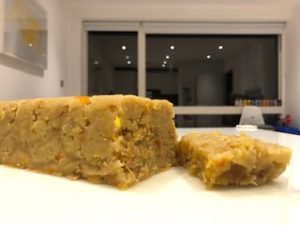Greek semolina halva with orange and honey
A few days ago, the Great British Bake Off crowned its 2020 winner. But don’t worry if you are yet to watch the final episode, I’m not going to spoil it for you. I am only going to say that it inspired me to take a break from my savoury bakes and make something sweet this week. Staying true to my roots, I opted for a traditional Greek dessert: halva.
The word ‘halva’ (‘halvas’ in Greek) is used to describe two different types of desserts: a semolina-based one and a tahini-based one, which is called ‘Makedonikos halvas’ (Macedonian halva). I made the former.
Traditionally, the recipe calls for 4 main ingredients: oil, semolina, sugar and water. In fact, it is pretty easy to remember the amounts of each ingredient: 1 cup oil, 2 cups semolina, 3 cups sugar and 4 cups water. However, as I’m in the habit of substituting sugar in my recipes, I used honey instead (only 2 cups, as it tends to be sweeter than sugar). I’ve also added a whole orange for flavour, as well as aromatic spices (cinnamon and cloves) and flaked almonds. I used a rectangular cake tin, a fairly unorthodox choice for this type of halva (it usually comes in a round shape).

Here is the recipe:
Ingredients:
1 cup Greek extra-virgin olive oil
2 cups semolina (1 cup coarse semolina, 1 cup fine semolina)
2 cups Greek honey
3 1/2 cups water
2 oranges (1 to be juiced, 1 to be cooked)
Spices: cinnamon (cloves, 1 cinnamon stick, ground cinnamon for serving)
100 grams flaked almonds
Method:
Place an orange in a pan full of water, and cook on low heat for 1-2 hours.
Cut the cooked orange in 8 slices, then blend those in a blender.
Juice the second orange (it will make 1/3 to 1/2 cup).
Toast the almond flakes in a baking pan lined with parchment paper for 10 minutes at 160 degrees.
Add the oil and the semolina in a second pan, and cook on low heat for about 30 minutes. Stir frequently, and make sure it doesn’t burn.
To make the syrup, add the honey, 3 1/2 cups of water, the orange juice, the cloves and the cinnamon stick in a third pan, and bring to the boil. Remove from the heat a couple of minutes after it starts boiling.
Then, remove the cloves and the cinnamon stick.
Remove the second pan (the one with the oil and the semolina) from the heat; slowly and carefully add the syrup into the second pan.
Add the blended orange into the second pan.
Return the second pan to low heat and cook for another 5-10 minutes. The halva is now cooked.
Add the flaked almonds to the halva and pour (or rather press) the mixture into a cake tin.
Let it set for a couple of hours, then turn the tin upside down onto a plate, and remove the tin.
Don’t forget to sprinkle the halva with a bit of cinnamon!
Further reading
For more mouth-watering Greek recipes, check out the following recently-published posts:
‘Traditional Greek stuffed vegetables‘
‘Baked tomato fritters from Santorini‘
‘Baked zucchini (courgette) fritters‘
‘Fava: a healthy Greek island recipe‘
‘Trahanas: heart-warming Greek winter recipes‘
‘6 delicious Greek summer recipes‘
‘Watermelon & feta: Mykonos-inspired recipes‘
‘Alex’s portokalopita (orange pie)’
Alex
(the Traveling Psychiatrist)